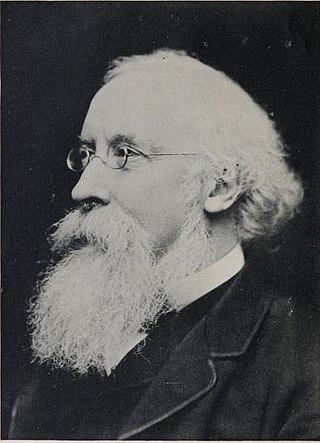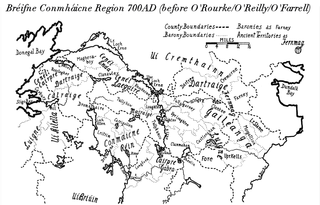Related Research Articles
In Irish mythology, Dian Cécht was the god of healing, the healer for the Tuatha Dé Danann, and son of the Dagda according to the Dindsenchas.

Whitley Stokes, CSI, CIE, FBA was an Irish lawyer and Celtic scholar.
Cairbre Nia Fer, son of Rus Ruad, was, according to medieval Irish legend and historical tradition, a King of Tara from the Laigin.
Lebor na hUidre or the Book of the Dun Cow is an Irish vellum manuscript dating to the 12th century. It is the oldest extant manuscript in Irish. It is held in the Royal Irish Academy and is badly damaged: only 67 leaves remain and many of the texts are incomplete. It is named after an anachronistic legend that it was made from the hide of a dun cow by Saint Ciarán of Clonmacnoise.
Cinioch, named Cínaed mac Luchtren or Ciniod I, in the Irish Annals, was king of the Picts, in modern Scotland, from circa 616 to 631, when his death is reported in the Annals of Ulster, the Annals of Tigernach and the Chronicon Scotorum.

Kuno Meyer was a German scholar, distinguished in the field of Celtic philology and literature. His pro-German stance at the start of World War I in the United States was a source of controversy. His brother was the distinguished classical scholar, Eduard Meyer.

Secundinus, or Sechnall as he was known in Irish, was founder and patron saint of Domhnach Sechnaill, County Meath, who went down in medieval tradition as a disciple of St Patrick and one of the first bishops of Armagh. Historians have suggested, however, that the connection with St Patrick was a later tradition invented by Armagh historians in favour of their patron saint and that Secundinus is more likely to have been a separate missionary, possibly a companion of Palladius.
Eochaid mac Colla, better known as Saint Dallán or Dallán Forgaill, was an early Christian Irish poet and saint known as the writer of the "Amra Coluim Chille" and, traditionally, "Rop Tú Mo Baile".
Dindsenchas or Dindshenchas, meaning "lore of places", is a class of onomastic text in early Irish literature, recounting the origins of place-names and traditions concerning events and characters associated with the places in question. Since many of the legends being related also concern the acts of mythic and legendary figures, the dindsenchas has been an important source for the study of Irish mythology.

Acallam na Senórach, is an important prosimetric Middle Irish narrative dating to c. 1200. It is the most important text of the Finn Cycle and at about 8,000 lines is the longest-surviving work of medieval Irish literature. It contains many Finn Cycle narratives framed by a story in which the fianna warriors and Caílte mac Rónáin have survived long enough to relate the tales to Saint Patrick. The work has been seen as a defence of the Irish literary establishment when it came under the scrutiny of Church reformers during the 12th to 13th centuries.
"Saint Patrick's Breastplate" is an Old Irish prayer of protection of the "lorica" type attributed to Saint Patrick.
An Leabhar Breac, now less commonly Leabhar Mór Dúna Doighre or possibly erroneously, Leabhar Breac Mic Aodhagáin, is a medieval Irish vellum manuscript containing Middle Irish and Hiberno-Latin writings. The manuscript is held in the library of the Royal Irish Academy in Dublin, where it is catalogued as RIA MS 23 P 16 or 1230.
Mongán mac Fíachnai was an Irish prince of the Cruthin, a son of Fíachnae mac Báetáin. Little is certainly known of Mongán's life as only his death is recorded in the Irish annals. He appears as a character in the Cycles of the Kings where he is said to have been the son of Manannán mac Lir and perhaps a reincarnation of the legendary hero Finn mac Cumaill of the Fenian Cycle.

Cath Finntrágha is an Early Modern Irish prose narrative of the Finn Cycle of Irish mythology. It dates probably to the 15th century in its current form, but apparently relied on older material. It concerns the deeds of the warrior-hero Finn mac Cumaill, his fianna, and, eventually, the gods and goddesses of Irish myth as they defend Ireland against a foreign invasion led by the world-king Dáire Donn. According to Derick Thomson, an 18th-century manuscript of the story in the Scottish Gaelic language also survives in the hand of iconic Scottish war poet Alasdair Mac Mhaighstir Alasdair.

The Masraige were a semi-legendary Fir Bolg tribe inhabiting Magh Slécht in County Cavan, Ireland. They were also called Masragii, Masraide, Masraidhe, Masruidhe, Mascraide, Masree, Macraighe or Mascraidhe. The name can be translated as "Beautiful/Fine-Looking/Handsome Folk", from Old Irish mass "fine, becoming, beautiful, handsome" and raige "pre-Gaelic tribe".
Cacht ingen Ragnaill was the queen of Donnchad mac Briain, from their marriage in 1032 to her death in 1054, when she is styled Queen of Ireland in the Irish annals of the Clonmacnoise group: the Annals of Tigernach and Chronicon Scotorum. Her husband himself, though King of Munster, is not widely regarded as having been High King of Ireland and so the extent of Cacht's influence is uncertain. That her style is superior to his presents an obviously strange situation in medieval Gaelic Ireland's male-dominated politics.
Disert is a townland in the civil parish of Kildallan, barony of Tullyhunco, County Cavan, Ireland.
Killallon civil parish is situated in the barony of Fore, County Meath. It has an area of 7,626 acres.

Kildallan is a townland in the civil parish of Templeoran, barony of Moygoish, County Westmeath, Ireland.
Kildallan North is a townland in the civil parish of Templeoran, barony of Moygoish, County Westmeath, Ireland.
References
- ↑ Goidelica. Old and Early-Middle-Irish Glosses, Prose and Verse. Edited by Whitley Stokes. 2nd ed., London, 1872 (Google Books)
- ↑ [crit. ed.] [tr.] Bisagni, Jacopo, Amrae Coluimb Chille: a critical edition, Early Irish Text Series 1, Dublin: Dublin Institute for Advanced Studies, 2019